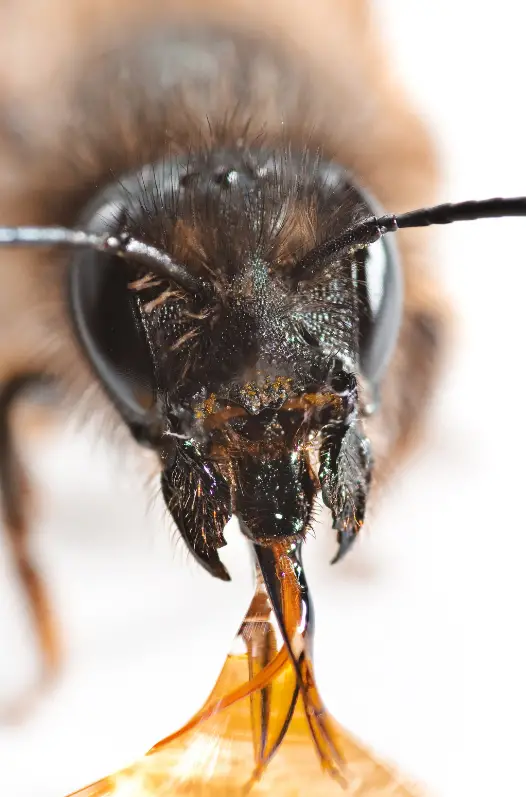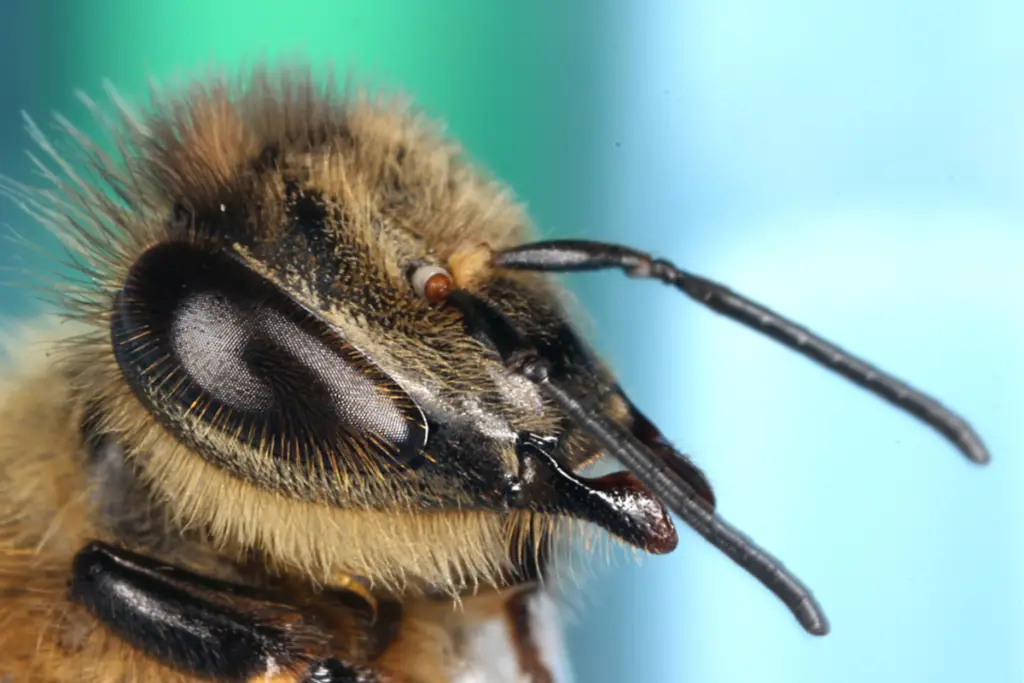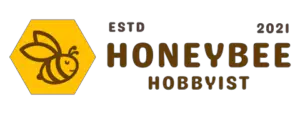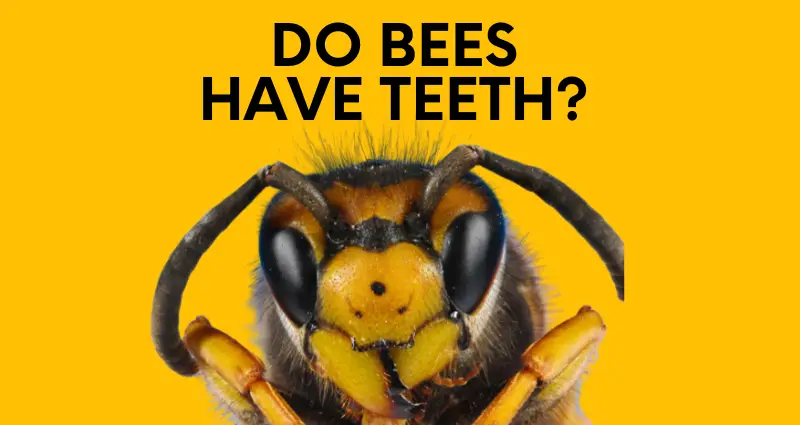Yes, bees have teeth but they are not like human teeth. Bee mandibles or jaws, include sharp or rounded points that are used to bite, chew, carry, and protect. The number of teeth varies among bee species.
Bees are not known for having a mouthful of pearly whites, yet they have mandibles or jaws that function like human teeth. The end of the mandible that protrudes from their head ends in jagged yet rigid grooves that are normally classified as teeth.
As the definition of “tooth” is any protruding object, even on a comb, saw, or a gear, it applies to bees.


How Do Bee Teeth Differ From What Humans Have?
Human teeth are built to bite and chew food. To avoid damage, dentists advise against opening bottles, cutting thread, chewing on hard objects like pen tops, or opening a package with their teeth, and even warn against chewing ice cubes. These activities can crack or chip a tooth or harm the gums. Tobacco, sugar, and incorrect brushing can compromise the enamel.
Bee’s teeth are extensions of the mandible, considered part of their exoskeleton rather than a separate structure. Bees have no bones, so they have no jaws to house the roots of teeth. As a result, some experts deny that the grooves on the ends of the bee mandible are teeth.
Don’t tell that to a bee, though, who uses its versatile mandible to do what teeth do in other creatures – and a lot more.
When you look at a bee head-on, you can see its toothed mandible along with pair of compound eyes on its face. The mandibles seem like pincers, but they are considered teeth.
Click here to learn more about honeybee anatomy.
What Is The Mandible On A Bee?
Bees have two movable jaws, known as mandibles, that swing in and out instead of up and down. Humans and other animals have one jaw that moves up and down and one jaw or maxilla that is stationary. Bees have two jaws, one on each side of the head, that each move and swing in and out.
When the bee is resting, the mandible folds over the labrum, a flap that protects the delicate tongue and other parts of the mouth like a sort of upper lip.
The toothed mandible is a bee’s Swiss army knife put to immediate use when the little bee comes out of her birth cell. She uses her mandible to chew her way out of the waxy cell, clean debris on the cell wall, and polish it for the next bee who emerges – a process known as wash boarding.
Other worker bees use their mandibles to repair any damage to the comb by manipulating the wax with their mandibles.

How Many Teeth Do Bees have?
The number of teeth on a bee’s mandible varies according to how many each bee species need.
Leafcutter and stingless bee varieties may have four or five on each mandible. The size of the bee mandible and the teeth on it is particularly large for the Wallace’s Giant Bee, with a wingspan of 2.5″, and the members of the Megachilidae family.
The teeth-like grooves on the mandible enable the bee to use it for many functions.
How Bee Mandibles Differ Between Hivemates
The three groups of residents in a beehive – the queen bee, the worker bees, and the drones – each use their teeth and mandibles a bit differently.
The queen bee, whose job it is to lay eggs, uses her mandibles for two purposes. First, when she is maturing in her wax cell, she uses her sharp teeth to escape the cell. She then visits other queen maturation cells in her hive, cuts into the tough wax cells, and effectively kills the potential queens. There is only one queen in a hive. Secretions from the queen bee’s mandibular gland also inhibit the development of ovaries in worker bees.
Drones, The male bees who impregnate the queen, spend most of their life outside the hive sleeping in flowers. The mandibles help the drone bee clutch the flower. When he wakes up, he releases his grasp and flies away. Without a stinger, the drone uses his teeth to defend himself against predators and other threats. However, drone mandibles are weak.
Male bumble bees fly in circles around their territory and may stop to mark it by releasing a scent, as they rapidly open and close their mandibles.
The female worker bees, the group responsible for the bee’s reputation as busy and industrious, use their mandibles for chewing and several other functions.
How Worker Bees Use Their Mandibles
Ironically, chewing is the weakest of all bee mandible functions. A bee cannot pierce flower petals or fruit skins but can penetrate a weak or delicate substance. It takes a group of bees to chew their way through a petal or enlarge a crevice that gets them closer to the nectar in a flower.
So, what do bees use their mandibles for then?
- They do not chew their food. The bee sucks water, honey, sweet juices, and nectar through a tube (the proboscis) supported by the mandible. Working together, the mouthparts of the bee enable both chewing and sucking.
- To manipulate parts of a flower and separate layers of petals to get at the nectar.
- Bring materials to their habitat. Bees chew wood or mud and carry them home to build their nest.
- Build the comb. Bees secrete a waxy substance from their glands which they shape with the mandibles to insert into the comb.
- Feed baby bee larvae. The mandibles are spoon-like, so the bees use them to bring food into the hive and push it into the honeycomb cells to feed the larvae.
- Mark territory. Bees release pheromones from the mandibular glands to keep enemies away.
- Fight predators. Using their teeth to bite varroa mites and other enemies, bees inject a paralyzing agent, 2-Heptanone, into them.
How Mandibles Vary Among Species Of Bees
Honeybees and other “buzz pollinators” may grab the anther on the stamen of a flower where the pollen accumulates with their mandible and shake it with their flight muscle until the pollen explodes for easy collection in the pollen basket. They may head-butt the flower to make this happen.
Other bee species have mandibles designed to be even more functional.
- Leafcutter bees from the Megachilidae family use their mandibles to cut pieces of leaf. They wrap their legs around a piece of a leaf as they cut to minimize wind resistance to fly home.
- Carpenter bees drill cylindrical cavities in wood to create galleries or nesting chambers and leave a pile of sawdust behind from their labors.
- Large bees from the Dianthidium genus gather pebbles and mud to build a stone hut on a tree branch.
- Mason bees (also Megachilidae members) used the mandible to gather mud and chewed leaves for the inner partitions of their hives.
- Wool carder bees accumulate balls of plant fiber in their mandibles to make their nests soft.
- The Megachile Pluto, or giant-jawed resin bee, slashes tree bark with its mandibles to get to the resin inside.
- The Megachile sculpturalis or sculptured resin bee coats rival carpenter bees with resin they prepare in their mandibles.
Click here to learn more about the differences between bee species.
Do Bees Bite With Their Teeth?
Some bees are known for their stings, but some with mandibles can bite predators, especially those too small to sting. The 2-Heptanone ketone they emit can paralyze tiny enemies, although it Is not strong enough to paralyze humans.
Biting enemies ward off enemies. Beekeepers of the Bombus genre regard this as grooming behavior that keeps honey bee colonies free of pests.
Multiple honey bee stings can kill humans, but some aggressive species of stingless bees may attack humans with their mandibles and even kill humans with enough bites.
Hornets also have mandibles, but theirs are so powerful that they can chew through human skin and inject them with deadly venom. Wasps seldom use their mandible to bite humans.


